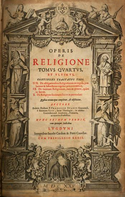This article needs additional citations for verification. (September 2016) |
| Part of the series on Modern scholasticism | |

| |
| Title page of the Operis de religione (1625) from Francisco Suárez. | |
| Background | |
|---|---|
|
Protestant Reformation | |
| Modern scholastics | |
|
Second scholasticism of the School of Salamanca | |
| Reactions within Christianity | |
|
The Jesuits against Jansenism | |
| Reactions within philosophy | |
|
Neologists against Lutherans | |
Second scholasticism,[1] also called Modern scholasticism, is the period of revival of scholastic system of philosophy and theology, in the 16th and 17th centuries. The scientific culture of second scholasticism surpassed its medieval source (Scholasticism) in the number of its proponents, the breadth of its scope, the analytical complexity, sense of historical and literary criticism, and the volume of editorial production, most of which remains hitherto little explored.
- ^ Manlio Bellomo, The Common Legal Past of Europe, 1000–1800, p. 225